Related Research Articles
Inertia is the natural tendency of objects in motion to stay in motion and objects at rest to stay at rest, unless a force causes the velocity to change. It is one of the fundamental principles in classical physics, and described by Isaac Newton in his first law of motion. It is one of the primary manifestations of mass, one of the core quantitative properties of physical systems. Newton writes:
LAW I. Every object perseveres in its state of rest, or of uniform motion in a right line, except insofar as it is compelled to change that state by forces impressed thereon.
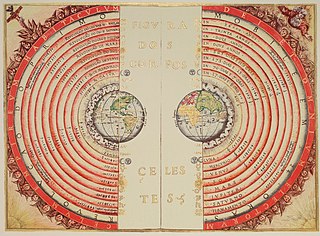
In astronomy, the geocentric model is a superseded description of the Universe with Earth at the center. Under most geocentric models, the Sun, Moon, stars, and planets all orbit Earth. The geocentric model was the predominant description of the cosmos in many European ancient civilizations, such as those of Aristotle in Classical Greece and Ptolemy in Roman Egypt, as well as during the Islamic Golden Age.

The Dialogue Concerning the Two Chief World Systems is a 1632 Italian-language book by Galileo Galilei comparing the Copernican system with the traditional Ptolemaic system. It was translated into Latin as Systema cosmicum in 1635 by Matthias Bernegger. The book was dedicated to Galileo's patron, Ferdinando II de' Medici, Grand Duke of Tuscany, who received the first printed copy on February 22, 1632.

The Discourses and Mathematical Demonstrations Relating to Two New Sciences published in 1638 was Galileo Galilei's final book and a scientific testament covering much of his work in physics over the preceding thirty years. It was written partly in Italian and partly in Latin.

The "Letter to The Grand Duchess Christina" is an essay written in 1615 by Galileo Galilei. The intention of this letter was to accommodate Copernicanism with the doctrines of the Catholic Church. Galileo tried to use the ideas of Church Fathers and Doctors to show that any condemnation of Copernicanism would be inappropriate.
Galileo's paradox is a demonstration of one of the surprising properties of infinite sets. In his final scientific work, Two New Sciences, Galileo Galilei made apparently contradictory statements about the positive integers. First, a square is an integer which is the square of an integer. Some numbers are squares, while others are not; therefore, all the numbers, including both squares and non-squares, must be more numerous than just the squares. And yet, for every number there is exactly one square; hence, there cannot be more of one than of the other. This is an early use, though not the first, of the idea of one-to-one correspondence in the context of infinite sets.

The Copernican Revolution was the paradigm shift from the Ptolemaic model of the heavens, which described the cosmos as having Earth stationary at the center of the universe, to the heliocentric model with the Sun at the center of the Solar System. This revolution consisted of two phases; the first being extremely mathematical in nature and the second phase starting in 1610 with the publication of a pamphlet by Galileo. Beginning with the 1543 publication of Nicolaus Copernicus’s De revolutionibus orbium coelestium, contributions to the “revolution” continued until finally ending with Isaac Newton’s work over a century later.
In physics, mechanics is the study of objects, their interaction, and motion; classical mechanics is mechanics limited to non-relativistic and non-quantum approximations. Most of the techniques of classical mechanics were developed before 1900 so the term classical mechanics refers to that historical era as well as the approximations. Other fields of physics that were developed in the same era, that use the same approximations, and are also considered "classical" include thermodynamics and electromagnetism.

The Galileo affair began around 1610, and culminated with the trial and condemnation of Galileo Galilei by the Roman Catholic Inquisition in 1633. Galileo was prosecuted for holding as true the doctrine of heliocentrism, the astronomical model in which the Earth and planets revolve around the Sun at the centre of the universe.
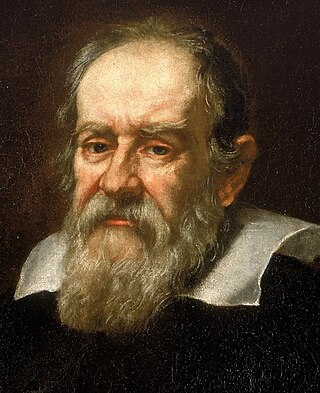
In physics, theories of gravitation postulate mechanisms of interaction governing the movements of bodies with mass. There have been numerous theories of gravitation since ancient times. The first extant sources discussing such theories are found in ancient Greek philosophy. This work was furthered through the Middle Ages by Indian, Islamic, and European scientists, before gaining great strides during the Renaissance and Scientific Revolution—culminating in the formulation of Newton's law of gravity. This was superseded by Albert Einstein's theory of relativity in the early 20th century.

The Assayer is a book by Galileo Galilei, published in Rome in October 1623. It is generally considered to be one of the pioneering works of the scientific method, first broaching the idea that the book of nature is to be read with mathematical tools rather than those of scholastic philosophy, as generally held at the time. Despite the retroactive acclaim given to Galileo's theory of knowledge, the empirical claims he made in the book—that comets are sublunary and their observed properties the product of optical phenomena—were incorrect.
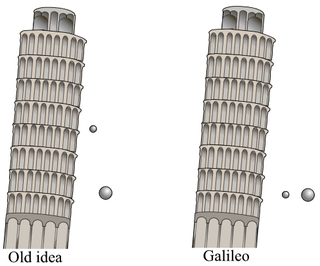
Between 1589 and 1592, the Italian scientist Galileo Galilei is said to have dropped "unequal weights of the same material" from the Leaning Tower of Pisa to demonstrate that their time of descent was independent of their mass, according to a biography by Galileo's pupil Vincenzo Viviani, composed in 1654 and published in 1717. The basic premise had already been demonstrated by Italian experimenters a few decades earlier.
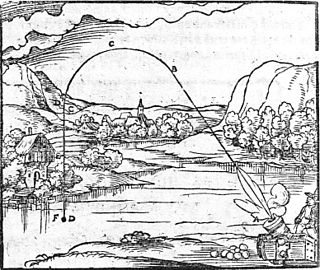
The theory of impetus is an auxiliary or secondary theory of Aristotelian dynamics, put forth initially to explain projectile motion against gravity. It was introduced by John Philoponus in the 6th century, and elaborated by Nur ad-Din al-Bitruji at the end of the 12th century. The theory was modified by Avicenna in the 11th century and Abu'l-Barakāt al-Baghdādī in the 12th century, before it was later established in Western scientific thought by Jean Buridan in the 14th century. It is the intellectual precursor to the concepts of inertia, momentum and acceleration in classical mechanics.

Filippo Vincenzo Romolo Salviati was an Italian nobleman, scientist and friend of Galileo. He is remembered today mainly because he appears as one of the figures in Galileo's controversial work the Dialogue Concerning the Two Chief World Systems (1632).

Mario Guiducci was an Italian scholar and writer. A friend and colleague of Galileo, he collaborated with him on the Discourse on Comets in 1618.

Galileo di Vincenzo Bonaiuti de' Galilei, commonly referred to as Galileo Galilei or mononymously as Galileo, was an Italian astronomer, physicist and engineer, sometimes described as a polymath. He was born in the city of Pisa, then part of the Duchy of Florence. Galileo has been called the father of observational astronomy, modern-era classical physics, the scientific method, and modern science.
De motu antiquiora, or simply De Motu, is Galileo Galilei's early written work on motion. It was written largely between 1589 and 1592, but was not published in full until 1890. De Motu is known for expressing Galileo's ideas on motion during his Pisan period prior to transferring to Padua.

Lodovico delle Colombe was an Italian Aristotelian scholar, famous for his battles with Galileo Galilei in a series of controversies in physics and astronomy.
Cesare Marsili was an Italian intellectual and associate of Galileo Galilei.
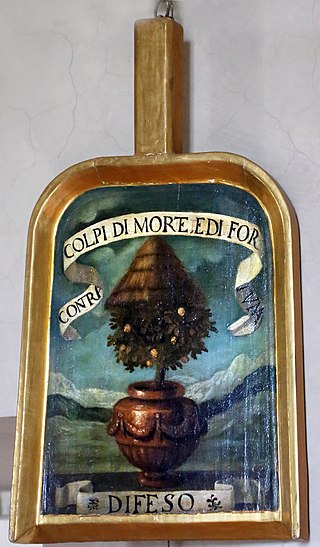
Niccolò Arrighetti was an Italian intellectual, pupil and associate of Galileo Galilei.
References
- ↑ Questions on Aristotle’s On the Heavens. Cambridge (Mass.), Medieval Academy of America (English translation by E.A. Moody of the c. 1340 Latin original)
- ↑ Le livre du Ciel et du Monde. Book II, Chapter 25 (manuscript). Paris, National Library.
- ↑ On Learned Ignorance. Minneapolis, The Arthur J. Banning Press (English translation by J. Hopkins of the 1440 Latin original).
- ↑ In sphaeram ioannis de sacro bosco commentarius, p. 196, "Neque enim valet responsio quorundam..."
- ↑ La Cena delle Ceneri, III, 5.
- ↑ Stillman Drake. Drake, Stillman (January 2003). Galileo at work, page 294. ISBN 9780486495422.
- ↑ Galileo Galilei. "Dialogue subject ship".
- ↑ Galileo Galilei. "Dialogo day two boat story (in italian, search at page for 'Riserratevi' yourself to find it)".